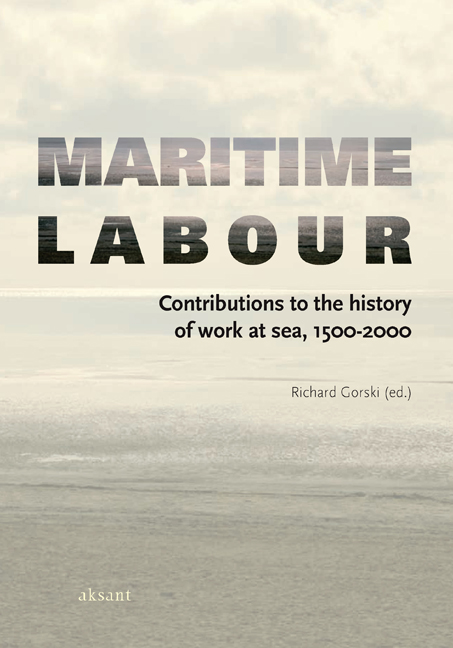Book contents
- Frontmatter
- Contents
- Introduction
- Six Cross-sections of the Dutch Maritime Labour Market: A Preliminary Reconstruction and its Implications (1610-1850)
- On Maritime Labour and Maritime Labour Markets in Germany, 1700-1900
- Swedish Naval Personnel in the Merchant Marine and in Foreign Naval Service in the Eighteenth Century
- Quantifying British Seafarers, 1789-1828
- ‘But for the Loves of the Fishes’: Maritime Labour and Ecological Culture in Nineteenth-century Newfoundland
- The Shipping Federation and the Free Labour Movement: A Comparative Study of Waterfront and Maritime Industrial Relations, c.1889-1891
- Health and Safety Aboard British Merchant Ships: The Case of First Aid Instruction, 1881-1908
- British Merchant Marine Engineer Licensing, 1865-1925
- Transatlantic Fishers: New England and British Trawlermen, 1960-1972
- Masters and chiefs: Enabling globalization, 1975-1995
- About the Contributors
Masters and chiefs: Enabling globalization, 1975-1995
Published online by Cambridge University Press: 26 January 2021
- Frontmatter
- Contents
- Introduction
- Six Cross-sections of the Dutch Maritime Labour Market: A Preliminary Reconstruction and its Implications (1610-1850)
- On Maritime Labour and Maritime Labour Markets in Germany, 1700-1900
- Swedish Naval Personnel in the Merchant Marine and in Foreign Naval Service in the Eighteenth Century
- Quantifying British Seafarers, 1789-1828
- ‘But for the Loves of the Fishes’: Maritime Labour and Ecological Culture in Nineteenth-century Newfoundland
- The Shipping Federation and the Free Labour Movement: A Comparative Study of Waterfront and Maritime Industrial Relations, c.1889-1891
- Health and Safety Aboard British Merchant Ships: The Case of First Aid Instruction, 1881-1908
- British Merchant Marine Engineer Licensing, 1865-1925
- Transatlantic Fishers: New England and British Trawlermen, 1960-1972
- Masters and chiefs: Enabling globalization, 1975-1995
- About the Contributors
Summary
Introduction
In the mid-1970s the shipping companies of Western Europe and Japan were predominant in international seaborne trade, their ships flying the flags and engaging crews congruent with the companies’ national locations. Twenty years later, Western European and Japanese shipping companies were still predominant but far less frequently flew flags signifying the national location of their operational centres. Even less frequently did they employ full crews of own-nationals. By the mid-1990s, after a decade and a half of depressed international trade, European and Japanese shipowners had adopted, in imitation of their North American counterparts, the recourse of flag of convenience ships crewed by seafarers who were neither of the same nationality as their ships’ owners, nor of the nation represented by their ships’ flags. In this new and much larger wave of flagging out companies’ assets (ships) were attached to such ‘offshore’ states as Panama, Liberia, Bahamas, Malta, Cyprus, and Europe's surrogate offshore states in the form of Norway's International Ship Register, the United Kingdom's Isle of Man and Bermuda, France's Kerguelen Islands, and Portugal's Madeira. Operational headquarters mostly stayed ‘at home’ (in the UK, Greece, Germany, Norway, Japan, etc). For their part, seafarers became itinerant workers.
The shipping industry's resort to a new national dress for its ships and the engagement of itinerant labour crews effectively mimicked the expedient adopted by the textile, clothing and footwear industries’ pursuit of significantly lower production costs through a mass exodus to locations abroad in the 1960s and 1970s. As with more recent industrial migrations – the ‘white goods’ industry is a good example – ownership and/or control has remained significantly with companies in Europe and Japan who operate overseas factories, licence local producers, or are quasi-monopoly buyers of output.
When compared with the migrations of other industries, the overseas shift for shipping was simpler and cheaper. The shipping industry did not need to relocate its ‘production units’. Ships were mobile and could therefore be readily ‘located’ to another national site. The signing of documents and the payment of an accompanying fee was enough to re-assign a ship's national identity.
- Type
- Chapter
- Information
- Maritime LabourContributions to the History of Work at Sea, 1500–2000, pp. 235 - 257Publisher: Amsterdam University PressPrint publication year: 2008



